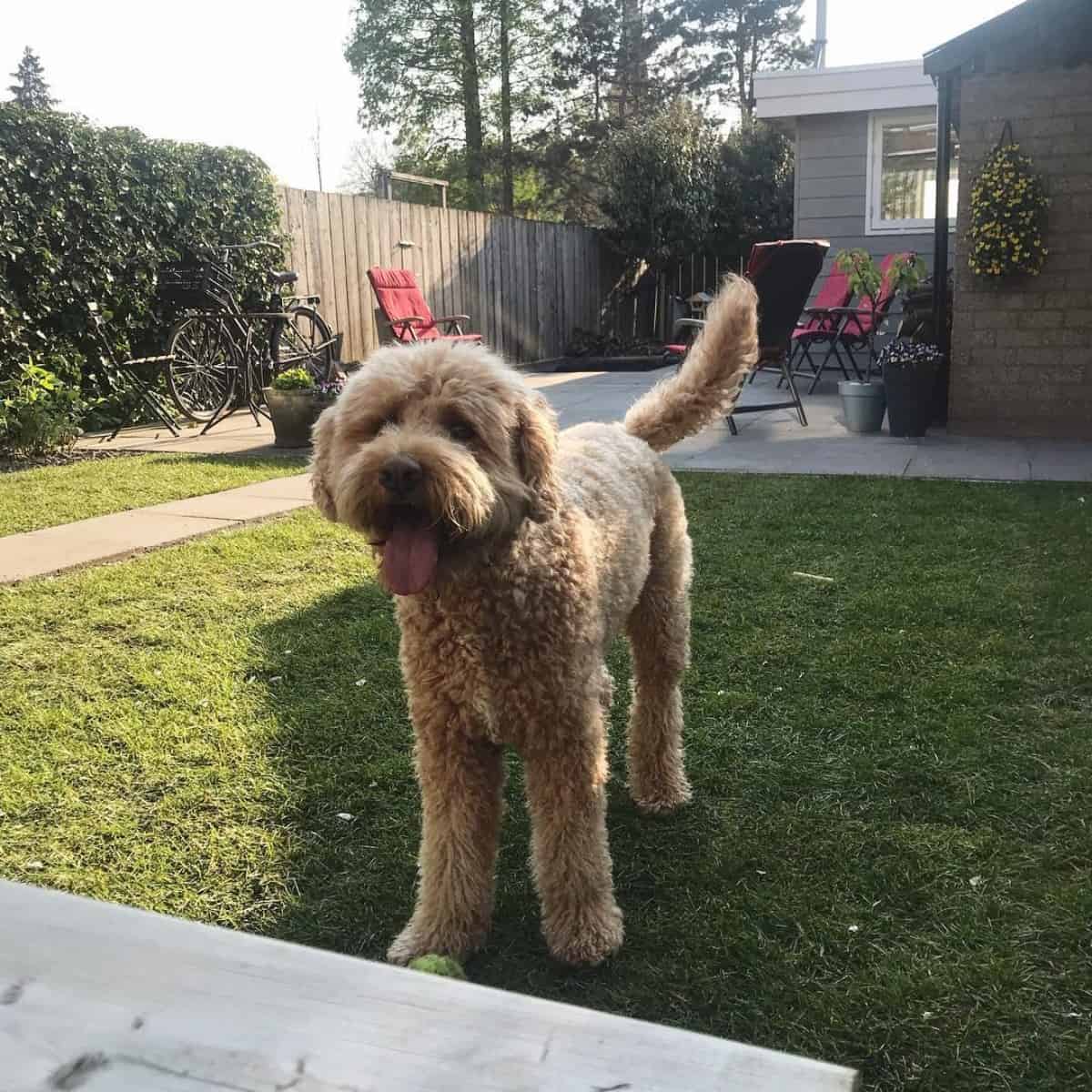Portuguese Water Dog vs Labradoodle

Back in 2009, when Barack Obama was President-elect, many dog lovers across the country were debating this very question. The Obamas ultimately decided on bringing a Portuguese Water Dog home to the White House. But both canines are magnificent breeds, and no matter their choice, either would have done well as the First Dog.
A decision due to allergies
During Obama’s first press conference following his election, he said that the family preferred opting for a dog from a shelter, quipping that “a lot of shelter dogs are mutts like me.” But in January 2009, when George Stephanopoulos asked President-elect Obama on ABC News’ “This Week” which breeds they were considering, Obama said that his daughters had narrowed their choice to either a Portuguese Water Dog or Labradoodle.
When asked why they’d narrowed their choice to these two breeds, President-elect Obama explained that both a Portuguese Water Dog and Labradoodle were good choices for people with allergies, like his daughter Malia’s. He then joked that “We’re closing in on it,” noting that “This has been tougher than finding a Commerce secretary.”
For many Americans, that was the first time they’d heard of the Portuguese Water Dog–and that included many dog lovers.

However, their decision process wasn’t without controversy. First, the American Kennel Club (AKC) does not officially recognize the Labradoodle as a breed since it’s a hybrid versus a purebred. (Please see the Labradoodle section below.) Therefore, some were concerned that the predictability of hybrids cannot be compared to that of purebreds.
Second, some were concerned that the increased interest in the Portuguese Water Dog among Americans could result in increased adoption of these dogs–and ultimately, an increased number of the dogs left in shelters.
Third, some were furious that Obama didn’t ultimately bring home a shelter dog. Due to such criticism, he promised to donate to the Humane Society.
What is a Portuguese Water Dog?
Also affectionately called Porties, the Portuguese Water Dog was originally bred to become a fisherman’s helper. These dogs are highly intelligent, athletic, and considered “biddable,” meaning they are eager to please and easily trained. They are medium-sized with a robust body and low-shedding coat ranging from loose and wavy to tight and curly.
Grooming considerations
According to the American Kennel Club, you can groom Porties in two different styles:
- the “lion clip,” where the fur on the muzzle and hindquarters is clipped to the skin
- the “retriever clip,” where the Portie’s entire coat is clipped to an inch, and the tail tip remains at full length
The Portie has a dense coat that is hypoallergenic. However, it’s important to provide regular, extensive grooming. Porties’ coats can be all brown or black or have small white patches. More recently, Porties also have developed primarily white coats with patches of color.

Health considerations
Porties are typically healthy dogs with an average life expectancy of 12 to 15 years. If you have a Portie canine pal, regularly check the Portie’s ears for any signs of infections. In addition, regularly brush your Portie’s teeth with a toothpaste specifically made for dogs.
Click here for information on health testing requirements approved by the Portuguese Water Dog Club of America, Inc.
Nutritional considerations
Ask your veterinarian and breeder for suggestions regarding high-quality dog food for your Portie, and be sure to provide an appropriate diet for your puppy’s or dog’s age. Always watch your dog’s weight and calories, particularly because some dogs tend to become overweight.
Using dog treats can be helpful for obedience training, but never provide too many treats since that may lead to obesity. Always contact your veterinarian if you have any questions or concerns regarding your dog’s weight.
In addition, importantly, always provide your dog with fresh, clean water to ensure proper hydration.
Exercise considerations
Regular, vigorous daily exercise is crucial for your Portie’s health. It will also keep your dog happy and prevent boredom. This includes long walks and playtime.
Many Porties enjoy physical and mental exercise, including engaging in canine sports. Porties particularly enjoy waterwork, such as dock diving. They also welcome participating in tracking, obedience, and other canine sports.
Temperament and training considerations
Porties are extremely smart and generally do well with obedience training. They love people and greet family and known friends enthusiastically.
However, due to their intelligence and natural exuberance, they may often think independently and be willful, challenging their owners. Therefore, as noted above, they require consistent positive training methods and daily physical and mental exercise.
What is a Labradoodle?

Unlike purebred Porties, Labradoodles are hybrid dogs, also known as designer dog breeds. In other words, they are hybrids that result from controlled crossbreeding between two purebred dogs. Hybrid dogs have two purebred parents that are usually purposefully bred to obtain the most desired characteristics of both breeds.
Per AKC statistics, Labrador Retrievers are the most popular dog breed in the U.S. They are usually extremely friendly, gentle dogs with even temperaments. They’re also typically highly trainable.
Poodles are also friendly dogs who love people. They’re known for being extremely intelligent and highly trainable.
Labradoodles who inherit both parents’ traits tend to be playful, friendly, affectionate, and trainable.
Grooming considerations
Labradoodles can vary from a miniature in size (~16 to 25 lbs) to medium (~30 to 40 lbs) to standard (~50 to 65 lbs). They can also have different appearances, with coats that are curly, wavy, curly, or wiry.
Their coats may be chocolate, gold and cream, red, brindle, and various combinations of such colors. In some litters, some Labradoodle puppies may appear more like their Labrador Retriever parent, while other siblings may appear more like their Poodle parent.
Many Labradoodles are hypoallergenic and relatively dander-free, inheriting such traits from their Poodle parents. Many owners prefer that their Labradoodles have fluffy coats. However, if you like to keep your Labradoodle’s coat long, it’s important to brush your dog to prevent matting.
Others elect to shave their Labradoodle’s fur to approximately an inch for easy grooming. Regardless, you should bring your Labradoodle to the groomer regularly–i.e., every few months–and also request a bath and nail trim.
Health considerations
As is the case with Porties, Labradoodles are generally healthy dogs and have an average life expectancy of 12 to 15 years. Yet they may have a risk for some of the same health issues as their Labrador Retriever or Poodle parents, including eye disease (i.e., progressive retinal atrophy), hip and elbow dysplasia, ear infections, epilepsy, allergies, and other conditions.
Ensure that your Labradoodle’s breeder provides you with health screening information for both canine parents and records of de-worming and vaccinations to date.

Nutritional considerations
Please see the section above regarding nutritional considerations for Porties, since the recommendations are the same for Labradoodles (and, frankly, any canine).
Exercise considerations
As with their Labrador Retriever and Poodle parents, Labradoodles are highly energetic and extremely active dogs, requiring regular daily exercise. They therefore also require plenty of active playtimes, long daily walks, and sufficient space to run.
Again, similarly to their parents, if they don’t receive sufficient physical and mental exercise, they tend to become bored and may begin to engage in poor behavior.

Temperament and training considerations
As with Porties, Labradoodles are highly trainable due to their eager, energetic, friendly personalities and high intelligence. They are both attentive and somewhat sensitive, so they respond best to positive reinforcement obedience training. In other words, praise your Labradoodle during training using treats (but not too many!) and happy, positive words and play.
Remember that Labradoodles need to receive regular mental and physical exercise. Otherwise, they’ll easily become bored, develop poor behaviors, and become anxious and nervous. Your training should include socializing them with other dogs early.

Portuguese Water Dog or Labradoodle: which is best for you?
As you can see, Porties and Labradoodles share so many positive characteristics, but only you and your family know the proper choice for you.
By the way, how did Obama’s choice work out? After bringing Bo, the male Portie, home to the White House as the First Dog, they later gave Bo a new Portie sister, named Sunny. Apparently, the entire First Family was happy with their choice!